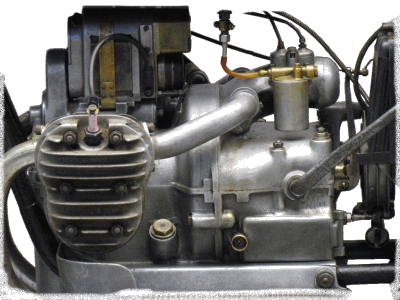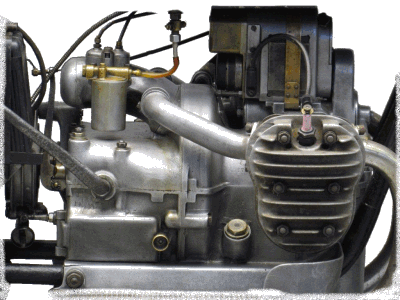|
¶ I'll condense hours and hours of study and research to one statement. the Engine Manufacture says, in the Engine Manufacturers engine and feel safe. ANY other oil run at 20 to 1." (20 parts gas to 1 part oil) In other words run Honda oil in Honda 2/strokes at Honda ratios. But if you run Honda oil in a Yamaha, run it at 20/1. Yamaha oil in a Honda? Same thing 20/1. They all say "Ours is the finest oil available." Trouble is they will not really tell you why.
Now, I know a lot of you out there who feel you can run things much leaner. Like 32 to 1 or 40 to 1 or even leaner. No less an expert than Bob Greene recommended a 32 to 1 mix and no less an expert than Gordon Jennings recommended a 20 to 1 mix. A lot of people run lean and a lot of them get away with it... and a lot of them don't. So what gives? I feel the problem is this. No one really knows at what dilution the 2-stroke oils are mixed at or exactly what additives are added. At least I don't, and I've tried to find out a number of times. They send you a bunch of specs but will only say "Ours is the finest available." They never say why their $3.00 a quart oil is better then the $5.00 a quart stuff. Here are a few ideas to consider.
Let's look at dilution. At least that's my word for it, and I don't really mean the weight of the oil either. Most say they are a 30w. I mean the ratio of the stuff that counts to the stuff they put in to make it look and mix good. That make sense? Probably not. Well, think of it this way. If oil "A" is twice as thick as oil "B" and you mix both at 40 to 1, oil "A" will really be 20 to 1, right? Now think about the reverse. If "A" is half as thick as oil "B" and you mix both at 40 to 1. "A" would now be 80 to 1. A bit lean right? I don't think the real dilution ratios, between different oils, are that big. I do think there is enough of a difference between 2-stroke oils to cause a problem. Especially when you consider the additive package.
What about additives? I think the manufacturers match the additive packages to the metallurgy of the metals in their engines. I once went to a Lawnboy lawnmower school where they bragged that the Lawnboy oil had almost no ash in it. They said this was really good for their engines. Another mechanic at the school said he had been to a Sachs chainsaw school and they told him there that the Sach engine needed ash. Their oil had lots of ash. Seems to me he said at least 2-3 % of ash, yet Lawnboy likes almost nothing... Why? What about the other additives in the package?
Here are some more things to consider. Most 2-stroke, motorcycle engines have fixed carb jets. This means changing the ratios will change the air fuel mix as oil is not gas. Change the ratios and you may need to rejet the carb.
I have noticed that as an engine wears out the quality of its combustion declines. In other words it does not burn the fuel mixture as good as it once did. (Well Duh!) As oil does not burn as good as gas, your plug tends to oil foul. Also, a worn engine will have worn seals too, letting oil in from the transmission. Now, you tell me. Do you maintain your Race Bike (and that CR, RM, KX, YZ, etc, IS a full blown Race Bike) to factory standards? Do you know what those standards are? You know... new rings every 3 motos, and all that other stuff? Hint... they are in your shop manual.
My point is this. With 20 to 1 you will get enough of what ever is needed to keep your engine running, no matter what the manufacturer wanted. When your buddies say run 40 or more to 1 on your oil, watch out. They may mean well, but what will it do to your bike over the long run? Are you running 40-50 to 1? I know of no scientifically run tests that show less oil is better for your engine. On the contrary, I know of several that show more oil, jetted right, in a good engine, gives more horsepower. If your engine does seem to run better on less oil, you just might need to rejet, rebuild, or retune. If you insist on running lean on the oil, you better have done your homework.
One thing I do know... the worst thing that's going to happen to your engine at 20 to 1 is a fouled plug and maybe your spark arrester screens plugging up. Too lean and... Now, if any of you oil manufacturers care to enlighten me with some facts and tests, it would sure make me happy if you would do so.
for Two Stroke Engines USA Mixtures Ounces of Oil to Gallons of Gas
To Use: Pick your ratio, pick the amount of gas you want to use and follow the columns and rows to the correct amount of oil. For 1 gallon at 20 to 1, follow the 1 gallon column down to the 20 to 1 row and you find you will need 6.4 Oz of oil. Metric Mixtures Milliliters of Oil to Liters of Gas
To Use: Pick your percentage or ratio, pick the amount of gas you want to use and follow the columns and rows to the correct amount of oil. For 1 liter at 5% (20 to 1), follow the 1 liter column down to the 5% row and you find you will need 50 Milliliters (ML) of oil per liter. If you want the above charts in a nice, easy to print, PDF form, here it is.   
Copyright © 1999-2004 dansmc.com. All rights reserved. |


